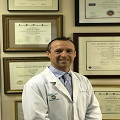
Russell D Weisz
Delray Medical Center, USA
Title: Extracellular matrix xenografts in the treatment of open fractures of the extremities with large soft tissue defects
Biography
Biography: Russell D Weisz
Abstract
Introduction: Application of biologic scaffolds such as extracellular matrix (ECM) products is a promising trend in the treatment of complex wounds in orthopedic trauma patients without the use of flap coverage.
Patients and Methods: Study included a cohort of patients with open fractures of bones and large skin defects. Wounds were complex in nature based on one of the following: 1) vascular injury with tissue ischemia, 2) large skin and soft tissue defects in challenging areas (e.g. plantar weight bearing aspect of the heel, high mobility zone of the antecubital fossa, etc.), 3) large area of exposed bone with no viable local rotational flap coverage, 4) type IIIB open tibia fractures. All patients underwent sequential debridements with provisional external and definitive internal stabilization of the skeletal injuries. Sequential xenograft applications of porcine urinary bladder ECM products (Cytel Wound Matrix and MatriStem MicroMatrix, ACell Inc. Columbia, MD) were performed from 2 to 4 times in each patient. In all patient’s negative pressure wound therapy (NPWT) was utilized.
Results: In all patient’s stable soft tissue coverage was achieved after xenograft implantation and regeneration of the granulation tissues which was followed by the split-thickness skin graft (STSG). Multiple applications of the ECM provided soft tissue coverage to a degree which alleviated the need for flap placement. In one area (heel) complete closure was achieved with the use of ECM sheets alone and without subsequent STSG.
Conclusions: The clinical outcomes demonstrated that even in challenging cases where local flap coverage of bone or neurovascular structures is not possible, sequential xenograft implantation allowed to achieve a stable soft tissue envelope. Different forms of ECM products are easy to apply in the presence of orthopedic hardware. In certain wounds, the complete closure can be achieved even without subsequent skin grafting. We recommend the relatively early application of xenograft.

